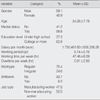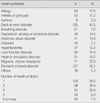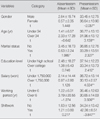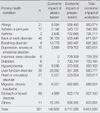Abstract
Purpose
The purpose of this study was to examine health problems and to estimate economic impact based on health problems of workers.
Methods
The subjects of this study consisted of 301 workers who received a group occupational health service. Data was collected from February 1 to March 30, 2006. The questionnaire contained questions based on general characteristics and the Stanford Presenteeism Scale. Data was analyzed with descriptive statistics, t-test using SPSS program.
Results
The primary health conditions as reported by workers were ranked in order as stomach or bowel disorders, back or neck disorders, or liver function disorders. The reason of absenteeism per worker was ranked in order as asthma, or a breathing disorder. The reason of presenteeism was ranked in order as asthma, insomnia or a sleep disorder. The cost of the total economic impact on the workplace in this study was 8,851,838 won. The cost of absenteeism per worker was 8,390 won. The cost of presenteeism per worker was 941,732 won.
Figures and Tables
References
1. Boles M, Pelletier B, Lynch W. The relationship between health risks and work productivity. Journal of Occupational and Environmental Medicine. 2004. 46:737–745.

2. Bramley TJ, Lerner D, Sarnes M. Productivity losses related to the common cold. Journal of Occupational and Environmental Medicine. 2002. 44:822–829.

3. Burton WN, Chen CY, Conti DJ, Schultz AB, Edington DW. The association between health risk change and presenteeism change. Journal of Occupational and Environmental Medicine. 2006. 48:252–263.

4. Burton WN, Chen CY, Conti DJ, Schultz AB, Pransky G, Edington DW. The association of health risks with on-the-job productivity. Journal of Occupational and Environmental Medicine. 2005. 47:769–777.

5. Burton WN, Pransky G, Conti DJ, Chen CY, Edington DW. The association of medical conditions and presenteeism. Journal of Occupational and Environmental Medicine. 2004. 46:S38–S45.

6. Cockburn IM, Bailit HL, Berndt ER, Finkelstein SN. Loss of work productivity due to illness and medical treatment. Journal of Occupational and Environmental Medicine. 1999. 41:948–953.

7. Collins JJ, Baase CM, Sharda CE, Ozminkowski RJ, Nioholson S, Billotti GM, et al. he assessment of chronic health conditions on work performance, absence, and total economic impact for employers. Journal of Occupational and EnvironmentalMedicine. 2005. 47:547–557.
8. Edington DW, Burton WN. McCunney RJ, editor. Health and productivity. A Practical approach to Occupational and Environmental Medicine. 2003. 3rd ed. Boston, MA: Little, Brown and Co;140.
9. Gilmour H, Patten SB. Depression and work impairment. Health Reports. 2007. 18:9–22.
10. Goetzel RZ, Long SR, Ozminkowski RJ, Hawkins K, Wang S, Lynch W. Health, absence, disability, and presenteeism cost estimates of certain physical and mental health conditions affecting U.S. employers. Journal of Occupational and Environmental Medicine. 2004. 46:398–412.

11. Hump P. Presenteeism: At work-but out of it. Harvard Business Review. 2004. 82:49–58.
12. Koopman C, Pelletier KR, Murray JF, Sharda CE, Berger ML, Turpin RS, et al. Stanford presenteeism scale: Health status and employee productivity. Journal of Occupational and Environmental Medicine. 2002. 44:14–20.

13. International statistics: major statistical index of OECD. 2007. November-a. Retrieved November 26, 2007. Korea National Statistical Office;from
http://www.kosis.kr/.
14. Employment:total economically active population according to gender and age. 2007. November-b. Retrieved November 16, 2007. Korea National Statistical Office;from
http://www.kosis.kr/domestic/theme/do01_index.jsp.
15. Health: Health examination of workers. 2007. November-c. Retrieved November 16, 2007. Korea National Statistical Office;from
http://www.kosis.kr/domestic /theme/do01_index.jsp.
16. Lang S. Economists coin term, 'presenteeism' for on-the-job health slow downs. 2005. Retrieved May 20, 2006. from
http://www.news.cornell.edu/Chronicle/04/4.22.04 /presenteeism.html.
17. Middaugh DJ. Presenteeism: sick and tired at work. Medsurg Nursing. 2006. 15:103–105.
18. Pelletier KR, Koopman C. Bringing health to the bottom line. Business & Health, Jun 15. 2003. June 15. Retrieved November 10, 2006. from
http://managedhealthcareexecutive.modernmedicine.com/mhe/Absenteeism/Bringing-Health-to-the-Bottom-Line/ArticleStandard/Article/detail/134250.
19. Ruez P. Quality and bottom line can suffer at the hands of the working sick. Managed Healthcare Executive. 2004. 14(11):46–48.
20. Sanderson K, Andrews G. Common mental disorders in the workforce: Recent findings from descriptive and social epidemiology. Canadian Journal of Psychiatry. 2006. 51(2):63–75.

21. Shamansky SL. Presenteeism or when being there is not being there. Public Health Nursing. 2002. 19:79–80.
22. Testa MA, Simonson DC. Health economic benefits and quality of life during improved glycemic control in patientswith type 2 diabetes mellitus: A randomized, controlled, double-blind trial. The Journal of the American Medical Association. 1998. 280:1490–1496.

23. Turpin RS, Ozminkowski RJ, Sharda CE, Collins JJ, Berger ML, Billotti GM, et al. Reliability and validity of the Stanford presenteeism scale. Journal of Occupational and Environmental Medicine. 2004. 46:1123–1133.

24. Yamashita M. Influential factors on presenteeism in 3 enterprises. 2007. Osaka, Japan: University of Osaka;Unpublished master's thesis.




 PDF
PDF ePub
ePub Citation
Citation Print
Print








 XML Download
XML Download